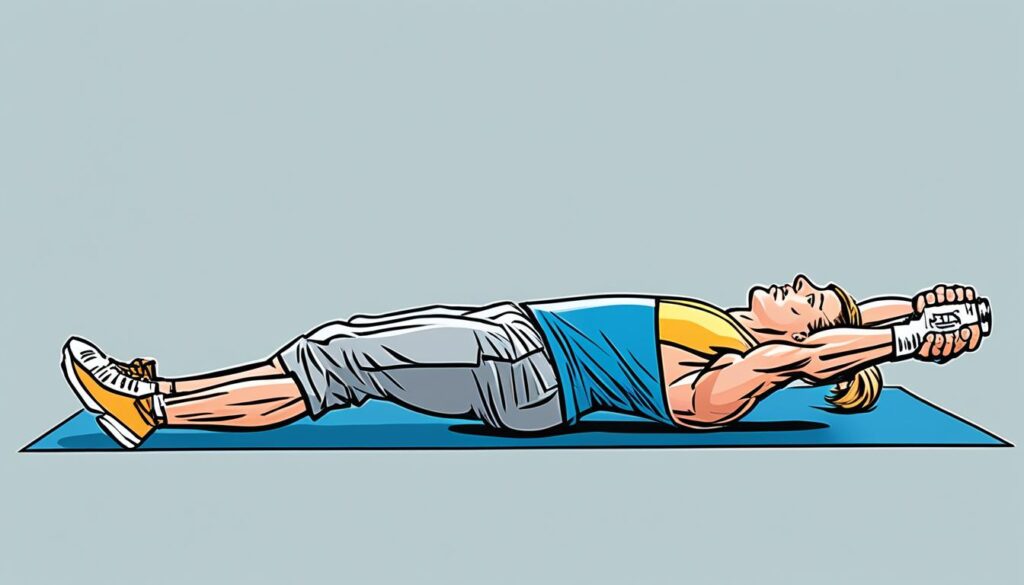Getting Started with hip raises
Did you know that strong glutes are not only essential for a shapely backside but also play a crucial role in overall stability and athletic performance? They are the powerhouse of your lower body, providing support and strength for various movements. That’s why incorporating hip raises, also known as glute bridges, into your routine can have a significant impact on your fitness journey.
When you think of glute exercises, squats may come to mind, but hip raises are often overlooked. However, they are incredibly effective in targeting and strengthening your glutes without putting excessive strain on your joints.
In this article, I’ll walk you through the benefits of hip raises, the proper technique to perform them, and how to integrate them into your fitness routine. Get ready to discover the secrets behind unlocking stronger glutes and enhancing your stability.
Key Takeaways:
- Hip raises, or glute bridges, are a powerful exercise for strengthening and toning your glutes.
- Strong glutes contribute to improved posture, reduced lower back pain, and enhanced athletic performance.
- The correct technique for hip raises involves lying on your back, engaging your core, and lifting your hips off the ground.
- Integrate hip raises into your routine as a standalone exercise or combine them with other lower body exercises for a well-rounded workout.
- Gradually progress the intensity of your hip raises by using resistance bands or dumbbells.
Understanding the Benefits of Hip Raises
Hip raises, also known as glute bridges, are an essential exercise for targeting your glute muscles. They offer a wide range of benefits that can greatly enhance your fitness routine. By incorporating hip raises into your regular workouts, you can expect improvements in various aspects of your fitness, including stronger glutes, increased hip mobility, and improved core stability.
One of the key advantages of hip raises is their ability to strengthen your glute muscles. The glutes, which consist of the gluteus maximus, medius, and minimus, are often referred to as the body’s powerhouse. They play a vital role in maintaining proper posture, supporting the lower back, and facilitating functional movements such as walking and running.
“The glute muscles play a crucial role in maintaining proper posture, reducing lower back pain, and improving athletic performance.”
By engaging in hip raises regularly, you can effectively target and activate these muscles, leading to increased strength and power in your lower body. Stronger glutes not only contribute to improved athletic performance but also aid in reducing the risk of injury and maintaining overall musculoskeletal health.
In addition to strengthening the glutes, hip raises also promote increased hip mobility. The hip joint is responsible for a wide range of movements, including flexion, extension, abduction, and adduction. However, many individuals experience limited hip mobility due to sedentary lifestyles and prolonged sitting.
By incorporating hip raises into your routine, you can actively engage the hip joint, improving its flexibility and range of motion. This increased mobility can have a positive impact on various activities, such as squatting, lunging, and running, allowing for more efficient and effective movement patterns.
Furthermore, hip raises contribute to improved core stability. When performing hip raises, you engage your core muscles to maintain balance and control throughout the movement. These deep core muscles include the transverse abdominis, internal and external obliques, and erector spinae.
By regularly engaging these muscles during hip raises, you can enhance your core stability and support the spine. This increased stability carries over to other exercises and daily activities, reducing the risk of lower back pain and improving overall functional fitness.
Benefits of Hip Raises:
- Strengthening the glutes
- Increasing hip mobility
- Improving core stability
- Enhancing athletic performance
- Reducing the risk of lower back pain
Overall, hip raises offer numerous benefits that make them a valuable addition to any fitness routine. Whether you are an athlete looking to enhance performance, a fitness enthusiast aiming to improve muscle strength, or an individual seeking to reduce lower back pain, incorporating hip raises into your workouts can be highly beneficial.
Next, let’s explore how to perform hip raises correctly to maximize their effectiveness.
| Benefits of Hip Raises |
|---|
| Strengthening the glutes |
| Increasing hip mobility |
| Improving core stability |
| Enhancing athletic performance |
| Reducing the risk of lower back pain |
How to Perform Hip Raises
To perform hip raises, follow these steps:
- Lie flat on your back with your knees bent and feet hip-width apart.
-
Engage your core and squeeze your glutes.
- Lift your hips off the ground, pushing through your heels, until your body forms a straight line from your knees to your shoulders.
- Hold for a few seconds at the top of the movement, focusing on keeping your glutes engaged.
- Slowly lower your hips back down to the starting position.
- Repeat the movement for the desired number of repetitions.
Remember to maintain proper form throughout the exercise. Avoid arching your lower back or overextending your hips. Focus on controlled movements and squeeze your glutes at the top of the movement to maximize the benefits of hip raises.
Integrating Hip Raises into Your Routine
Hip raises are a valuable addition to any workout routine. They can be performed as a standalone exercise or incorporated into a circuit training routine. Adding variation to your workouts is vital for continuous progress and preventing plateaus.
If you’re looking to increase the intensity of your hip raises, incorporating dumbbells or resistance bands can provide that extra challenge. Using a dumbbell or resistance band adds resistance to the movement, engaging your glutes and core even more. Start with a lighter weight and gradually increase as you build strength and confidence.
For a well-rounded lower body workout, combine hip raises with other compound exercises. Pull-ups are an effective upper body exercise that engages multiple muscle groups, including the back and arms. Squats target your quads, hamstrings, and glutes, making them a perfect complement to hip raises. Lastly, lunges work your legs and glutes while also improving your balance and stability.
Tips for Effective Integration:
- Start with a proper warm-up to prepare your muscles for the workout.
- Add hip raises to your routine 2-3 times per week.
- Perform 3-4 sets of 10-15 repetitions, depending on your fitness level.
- Focus on maintaining proper form throughout the exercise.
- Listen to your body and adjust the intensity and weight accordingly.
- Allow for adequate rest and recovery between workouts.
By integrating hip raises into your routine and combining them with other exercises, you can achieve a well-balanced workout that targets multiple muscle groups. Remember to always consult with a fitness professional before starting a new exercise program, especially if you have any pre-existing conditions or injuries.

Keep challenging yourself and enjoy the benefits of a stronger, more stable lower body!
Conclusion
Hip raises are an essential exercise for strengthening your glutes and improving stability. By incorporating hip raises into your regular fitness routine, you can achieve stronger glutes, better posture, and enhanced athletic performance.
When starting with hip raises, it’s important to focus on proper form. Begin by lying flat on your back, engage your core, and lift your hips off the ground. Gradually increase the intensity of the exercise by adding dumbbells or resistance bands.
Listen to your body and make adjustments as needed. Remember, consistency is key. By including hip raises in your routine on a regular basis, you can maximize the benefits of this versatile exercise and continue progressing towards your fitness goals.
FAQ
What muscles do hip raises target?
Hip raises primarily target the glute muscles, specifically the gluteus maximus. They also engage the hamstrings and lower back muscles.
How can hip raises improve my athletic performance?
By strengthening the glutes and improving hip mobility, hip raises can help enhance athletic performance by increasing power, stability, and overall movement efficiency.
Can I add weight to my hip raises?
Yes, you can add resistance to your hip raises by using a dumbbell, resistance band, or barbell placed on your hips. This can increase the intensity of the exercise and further challenge your glute muscles.
Can hip raises be performed with other exercises?
Absolutely! Hip raises can be integrated into your workout routine in combination with exercises such as pull-ups, squats, lunges, and other lower body exercises to create a comprehensive lower body workout.
How many repetitions of hip raises should I do?
The number of repetitions can vary depending on your fitness level and goals. Start with 8 to 12 repetitions and gradually increase over time as your strength and endurance improve.
